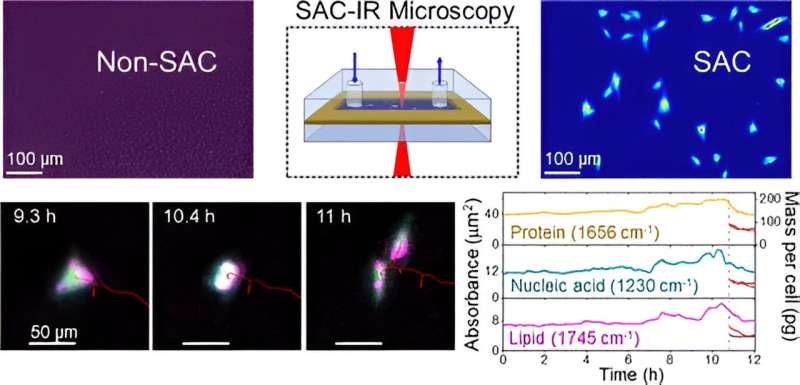Researchers at the National Institute of Standards and Technology (NIST) have developed a way to use infrared light to detect molecules inside living cells, with an unprecedented level of clarity. This important step towards using super-resolution techniques in live cell imaging has the potential to open new routes towards rapid, quantitative and ubiquitous observation of the intricate machinery that makes life possible, ultimately driving biotechnological advancements by expanding the horizons for drug discovery and many more applications.

Unmasking the Invisible
It is challenging to follow the actions of tiny biomolecules of life in IR light within living cells. The problem? Water, the most prevalent molecule in and outside cells by far, absorbs IR with such intensity that it largely overlaysthe absorption signals of other vital biomolecules (proteins, lipids, nucleic acids).
The researchers at NIST, however, have now developed an innovative technique for solvent absorption mitigation called Solvent Absorption Compensation (SAC) that employs a patented optical element to remove the water contribution and expose the real infrared absorbance signatures of the constituent cell biomolecules. This has allowed the detection, and tracking of changes in these essential biomolecules over long periods and through regions teeming with water.
Unlocking the Cell’s Secrets
This Novel SAC-IR (Solvent Absorption Compensation Infrared) method is also of high significance as it is useful for prediction of moisture in range from 0.02 % to few %. Cancer cell therapy, where a patients’ own immune cells are altered to more effectively identify and attack cancer cells — particularly important in this field as the modified cells will need to be tested for safety and efficacy once they are reintroduced. The data from SAC-IR can show how the cells are altered on the biomolecular level, making it possible to tell how well they are doing.
In addition to cell therapy, it could be applied to drug screening and development. The ability to quantify the absolute levels of different biomolecules in single cells is a significant advance for assessing the potency and safety profiles of novel drug candidates. Moreover, this approach could help answer long standing questions in cell biology such as what a molecular signature of viability (alive, dead or dying) look like.
An example of another potential application is in the area of cell preservation and cryopreservation. One issue concerned about is the viability of cells when they have been in frozen state for months or years and then get thawed out to use again. By analyzing the expression via the IR spectra of a single AMD mouse model, SAC-IR method might help researchers to improve the cell-freezing/thawing processes and choose the best conditions that maintain maximum viability.
Conclusion
The invention of the SAC-IR technique by NIST researchers is truly revolutionary within biotechnology and cell biology. And this method gets around the problem of water absorption, so that scientists can watch the complex and subtle biochemical reactions inside living cells in exquisite detail. This technology has many potential applications, such as accelerating drug development and cell therapy development or helping us understand basic cell biology. With further refinement and development of the SAC-IR technique, we can look forward to more exciting developments in biomedicine and biotechnology moving forwards.
